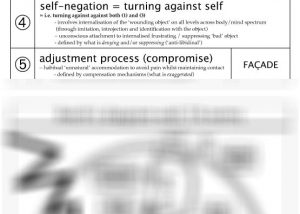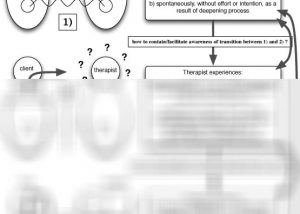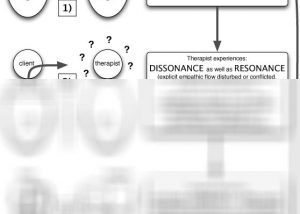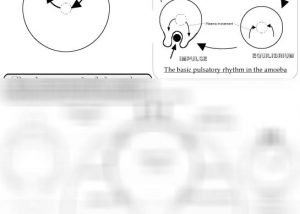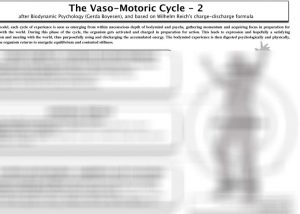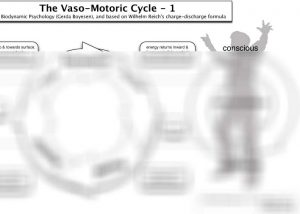About our CPD Resources
For the last few years, all of these have been publicly available, but from now on - as previously announced - access to most of the resources is restricted to subscribers/members of the site.It is free to register for the site, and it only takes a minute - all you need to do is give your name and email, and you will receive a confirmation email. As a member of the site you will then receive occasional newsletter updates, never more than 6 per year (usually it’s about 4).
Once you have registered, every time you want to access any of the resources, all you need to do is log-in to the site, using the log-in link in the top right corner of each page. You are welcome to use and distribute these materials, including for your own teaching, as long as you reference them and observe the copyright, by keeping copyright details visible.
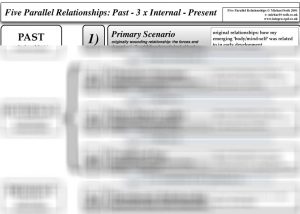
5 Parallel Relationships (early version) (1996)
This handout is a more complex elaboration of the previous one, based upon further distinguishing the internal object relations (i.e. the ways in which the client is relating to themselves, and the multiple self states involved) into three further parallels: [...]

Collective Mothering and the Medical Model – EJP Letter (1996)
A Letter in response to Emmy van Deurzen-Smith's 1996 paper 'The Future of Psychotherapy', taking issue with her suggestion that some of what used to be the intuitive art and craft of mothering could and should now be provided by [...]
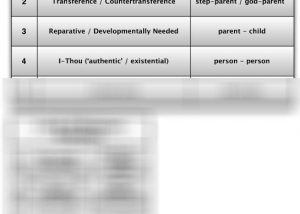
Petruska Clarkson’s ‘Five Modalities of the Therapeutic Relationship’ (1995)
This handout is a simple summary in table form of the modalities of the therapeutic relationship, as initially formulated by Petruska Clarkson in her seminal 1991 paper: ""Clarkson, P (1991) A Multiplicity of Psychotherapeutic Relationships, in British Journal of Psychotherapy, [...]
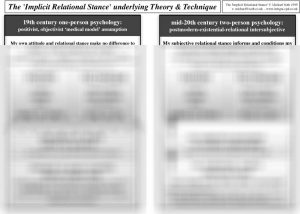
The Implicit Relational Stance Underlying Theory and Technique (1995)
This is a more detailed updated version of this handout (earliest version 1995). I had been working with the notion of the therapist's 'habitual position' since the mid-1990s, after we had recognised for some years that students were attracted to [...]
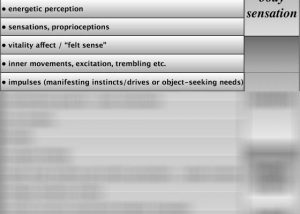
Levels of BodyMind – BODY – EMOTION – IMAGINATION – MIND – INTUITION (1995)
This handout is an attempt to appreciate the many subtleties and layers we can distinguish in terms of bodymind process, reaching from the most basic physiological via the emotional, imaginal and mental toward intuition. We can think of these levels [...]
Character Formation – 5 Steps (1995)
This is a slightly reformulated version of Stephen Johnson's 5 steps of character formation. These five steps are the basic process by which developmental, relational injury occurs and leads to 'turning against the self' and chronic character formation. While rooted [...]

Character Formation: Reich’s diagram of ‘turning against self’ (1995)
This is Reich's diagram of an impulse 'turning back against itself'. This diagram is easier to understand if we illustrate it with terms drawn from Transactional Analysis. Turning against the self in character formation implies chronic internal conflict, based on [...]
Character Formation (1995)
This is a summary of the previous two handouts on one page - both a description of the 5 steps of character formation and Reich's diagram of an impulse 'turning back against itself', using terms from Transactional Analysis. This early [...]
Three Kinds of Contact (1995)
This handout is one of the most basic and fundamental to a relational perspective on therapy. If it is indeed 'the relationship that matters', what kinds of contacts can exist between client and therapist? Alongside the different modalities of therapeutic [...]
Three Kinds of Contact (1995, simple)
This handout is one of the most basic and fundamental to a relational perspective on therapy. If it is indeed 'the relationship that matters', what kinds of contacts can exist between client and therapist? Alongside the different modalities of therapeutic [...]
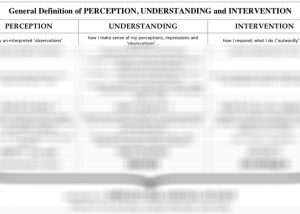
Perception Understanding Intervention (1994)
Perception, understanding and therapeutic response/intervention are shaped by the therapist's implicit relational stance (in the paradigm clash between the polarities of 'medical model' versus 'anti-medical model', and integrated by a third paradoxical position: holistic-systemic-relational). After using earlier and more confused [...]

An Integrative Triangle: Freud, Reich and Jung (1994)
Incomplete notes for a paper given at the UKAPI Conference 2001, suggesting that Freud, Jung and Reich can be seen as championing in some respects three mutually exclusive, but actually complementary perspectives, each with its own blessings and shadow aspects. [...]

An Integrative Perspective on Two-Chair Work (1993)
This is a paper written initially as a summary hand-out for my workshops on 'Working with Dialogue / Two-Chair Work', I have been working on a much longer version over the years, leading towards a manual for this therapeutic tool [...]
Parental Identification (1992)
This is an early paper written for a staff training workshop, based on the recognition that object relations are both internalised and embodied. This affects our view of our clients, but also of our own habitual positions as therapists. To [...]
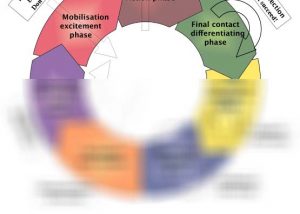
The Gestalt Cycle (including typical contact disturbances) (1992)
This handout is a modern version of the cycle of Gestalt formation and destruction - the way new experiences move into the foreground, become figural, are engaged with and then eventually lose interest. In this modern diagram (based upon Clarkson/Sills/Lapworth), [...]
The Gulf in ‘me’ (1992)
Subtitled "A psychotherapist's view of the Gulf War", this was an attempt at formulating some principles of personal-political engagement and to contribute a psychological dimension to the political debate, by finding the global leaders within our own dreams and 'inner [...]
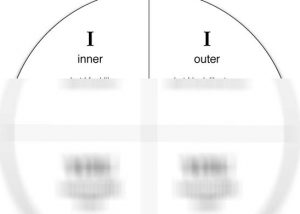
Maps of Wholeness – E.F. Schumacher’s ‘Four Fields of Knowledge’ (1992)
I have included some handouts based upon E.F. Schumacher's brilliant little book ""A Guide for the Perplexed"" (1977) - written towards the end of his life in presenting a distillation of basic his beliefs and principles. His distinction of the [...]
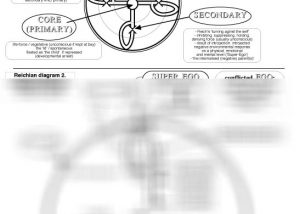
Character Formation – Primary, Secondary, Facade (early version 1992)
This handout combines Reich's diagram of a blocked and repressed impulse (the 'turning-against-the-self') with the three layers of character armour. In this handout the three layers are explained in some detail (top half of page). This diagram is easier to [...]
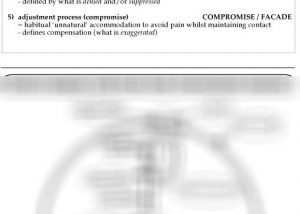
Character Formation – 5 Steps (early version 1992)
This handout combines a more detailed version of 5 steps of character formation as formulated by Stephen Johnson (see ""Character Styles"" 1994), but based on Wilhelm Reich and Alexander Lowen, with Reich's diagram of an impulse turning back against itself. [...]
The Vasomotoric Cycle – Amoeba (1991)
This old handout relates Gerda Boyesen's 'Vasomotoric Cycle' more explicitly to Wilhelm Reich's much earlier ideas (charge-discharge sequence) and actual microscopic research into the pulsation cycle of unicellular organisms (amoeba). Reich is known to have formulated some radical ideas about [...]
The Vasomotoric Cycle 2 (1990, 2005)
This handout extends in more detail Gerda Boyesen's (Biodynamic Psychology) concept of the 'Vasomotoric Cycle', and how an impulse evolves and goes through a cycle. Although slightly oversimplifying, it is based on the idea that emotions and feelings emerge from [...]
The Vasomotoric Cycle 1 (1990, 2005)
This handout illustrates the basic principle of Gerda Boyesen's (Biodynamic Psychology) concept of the 'Vasomotoric Cycle'. The assumption is (similar to the Gestalt cycle - see other handout), that human experience goes through continuous cycles, which can be complete or [...]
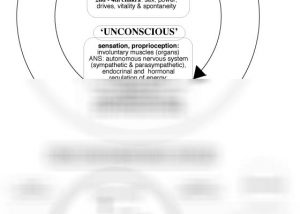
The Vasomotoric Cycle (1990, old version)
This is the oldest version of this handout, basically copied across from how the notion of the Vasomotoric Cycle was developed, understood and taught already at the Boyesen Centre since the 1970s. It was taken for granted that this was [...]

